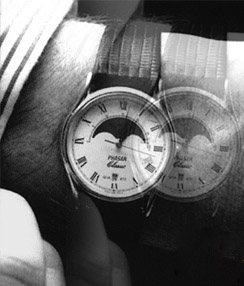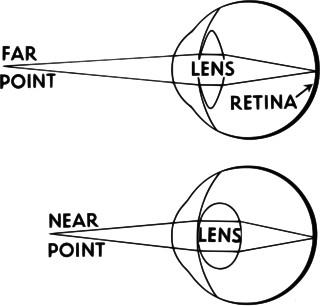
Esotropia is a form of strabismus in which one or both eyes turns inward. The condition can be constantly present, or occur intermittently, and can give the affected individual a "cross-eyed" appearance. It is the opposite of exotropia and usually involves more severe axis deviation than esophoria. Esotropia is sometimes erroneously called "lazy eye", which describes the condition of amblyopia; a reduction in vision of one or both eyes that is not the result of any pathology of the eye and cannot be resolved by the use of corrective lenses. Amblyopia can, however, arise as a result of esotropia occurring in childhood: In order to relieve symptoms of diplopia or double vision, the child's brain will ignore or "suppress" the image from the esotropic eye, which when allowed to continue untreated will lead to the development of amblyopia. Treatment options for esotropia include glasses to correct refractive errors, the use of prisms, orthoptic exercises, or eye muscle surgery. The term is from Greek eso meaning "inward" and trope meaning "a turning".

In biology, binocular vision is a type of vision in which an animal has two eyes capable of facing the same direction to perceive a single three-dimensional image of its surroundings. Binocular vision does not typically refer to vision where an animal has eyes on opposite sides of its head and shares no field of view between them, like in some animals.
Orthoptics is a profession allied to the eye care profession. Orthoptists are the experts in diagnosing and treating defects in eye movements and problems with how the eyes work together, called binocular vision. These can be caused by issues with the muscles around the eyes or defects in the nerves enabling the brain to communicate with the eyes. Orthoptists are responsible for the diagnosis and non-surgical management of strabismus (cross-eyed), amblyopia and eye movement disorders. The word orthoptics comes from the Greek words ὀρθός orthos, "straight" and ὀπτικός optikοs, "relating to sight" and much of the practice of orthoptists concerns disorders of binocular vision and defects of eye movement. Orthoptists are trained professionals who specialize in orthoptic treatment, such as eye patches, eye exercises, prisms or glasses. They commonly work with paediatric patients and also adult patients with neurological conditions such as stroke, brain tumours or multiple sclerosis. With specific training, in some countries orthoptists may be involved in monitoring of some forms of eye disease, such as glaucoma, cataract screening and diabetic retinopathy.

Strabismus is a vision disorder in which the eyes do not properly align with each other when looking at an object. The eye that is pointed at an object can alternate. The condition may be present occasionally or constantly. If present during a large part of childhood, it may result in amblyopia, or lazy eyes, and loss of depth perception. If onset is during adulthood, it is more likely to result in double vision.

Diplopia is the simultaneous perception of two images of a single object that may be displaced horizontally or vertically in relation to each other. Also called double vision, it is a loss of visual focus under regular conditions, and is often voluntary. However, when occurring involuntarily, it results in impaired function of the extraocular muscles, where both eyes are still functional, but they cannot turn to target the desired object. Problems with these muscles may be due to mechanical problems, disorders of the neuromuscular junction, disorders of the cranial nerves that innervate the muscles, and occasionally disorders involving the supranuclear oculomotor pathways or ingestion of toxins.
Vision therapy (VT), or behavioral optometry, is an umbrella term for alternative medicine treatments using eye exercises, based around the pseudoscientific claim that vision problems are the true underlying cause of learning difficulties, particularly in children. Vision therapy has not been shown to be effective using scientific studies, except for helping with convergence insufficiency. Most claims—for example that the therapy can address neurological, educational, and spatial difficulties—lack supporting evidence. Neither the American Academy of Pediatrics nor the American Academy of Ophthalmology support the use of vision therapy.

A vergence is the simultaneous movement of both eyes in opposite directions to obtain or maintain single binocular vision.

Exotropia is a form of strabismus where the eyes are deviated outward. It is the opposite of esotropia and usually involves more severe axis deviation than exophoria. People with exotropia often experience crossed diplopia. Intermittent exotropia is a fairly common condition. "Sensory exotropia" occurs in the presence of poor vision in one eye. Infantile exotropia is seen during the first year of life, and is less common than "essential exotropia" which usually becomes apparent several years later.
The Optometric Extension Program Foundation (OEPF) is an international, non-profit organization dedicated to the advancement of the discipline of optometry, with recent emphasis on behavioral optometry and vision therapy.
An eye care professional is an individual who provides a service related to the eyes or vision. It is any healthcare worker involved in eye care, from one with a small amount of post-secondary training to practitioners with a doctoral level of education.
Positive relative accommodation (PRA) in biology, is a measure of the maximum ability to stimulate eye accommodation while maintaining clear, single binocular vision. This measurement is typically obtained by an orthoptist, ophthalmologist or optometrist during an eye examination using a phoropter. After the patient's distance correction is established, she or he is instructed to view small letters on a card 40 cm from the eyes. The examiner adds lenses in −0.25 diopter increments until the patient first reports that they become blurry. The total value of the lenses added to reach this point is the PRA value.

Fixation disparity is a tendency of the eyes to drift in the direction of the heterophoria. While the heterophoria refers to a fusion-free vergence state, the fixation disparity refers to a small misalignment of the visual axes when both eyes are open in an observer with normal fusion and binocular vision. The misalignment may be vertical, horizontal or both. The misalignment is much smaller than that of strabismus. While strabismus prevents binocular vision, fixation disparity keeps binocular vision, however it may reduce a patient's level of stereopsis. A patient may or may not have fixation disparity and a patient may have a different fixation disparity at distance than near. Observers with a fixation disparity are more likely to report eye strain in demanding visual tasks; therefore, tests of fixation disparity belong to the diagnostic tools used by eye care professionals: remediation includes vision therapy, prism eye glasses, or visual ergonomics at the workplace.

A Brock string is an instrument used in vision therapy. It consists of a white string of approximately 10 feet in length with three small wooden beads of different colors.
Suppression of an eye is a subconscious adaptation by a person's brain to eliminate the symptoms of disorders of binocular vision such as strabismus, convergence insufficiency and aniseikonia. The brain can eliminate double vision by ignoring all or part of the image of one of the eyes. The area of a person's visual field that is suppressed is called the suppression scotoma. Suppression can lead to amblyopia.

Stereopsis recovery, also recovery from stereoblindness, is the phenomenon of a stereoblind person gaining partial or full ability of stereo vision (stereopsis).
Accommodative infacility also known as accommodative inertia is the inability to change the accommodation of the eye with enough speed and accuracy to achieve normal function. This can result in visual fatigue, headaches, and difficulty reading. The delay in accurate accommodation also makes vision blurry for a moment when switching between distant and near objects. The duration and extent of this blurriness depends on the extent of the deficit.
Susan A. Cotter is a professor of optometry at the Southern California College of Optometry (SCCO) at Marshall B. Ketchum University where she teaches in the classroom and clinic, works with the residents, and conducts clinical researches. Her scientific work is related to related to clinical management strategies for strabismus, amblyopia, non-strabismic binocular vision disorders, and childhood refractive error.
In ophthalmology, horror fusionis is a condition in which the eyes have an unsteady deviation, with the extraocular muscles performing spasm-like movements that continuously shift the eyes away from the position in which they would be directed to the same point in space, giving rise to diplopia. Even when the double vision images are made to nearly overlap using optical means such as prisms, the irregular movements prevent binocular fusion. The name horror fusionis arises from the notion that the brain is, or at least appears to be, actively preventing binocular fusion.

The prism fusion range (PFR) or fusional vergence amplitude is a clinical eye test performed by orthoptists, optometrists, and ophthalmologists to assess motor fusion, specifically the extent to which a patient can maintain binocular single vision (BSV) in the presence of increasing vergence demands. Motor fusion is largely accounted to amplitudes of fusional vergences and relative fusional vergences. Fusional vergence is the maximum vergence movement enabling BSV and the limit is at the point of diplopia. Relative fusional vergence is the maximum vergence movement enabling a patient to see a comfortable clear image and the limit is represented by the first point of blur. These motor fusion functions should fall within average values so that BSV can be comfortably achieved. Excessive stress on the vergence system or inability to converge or diverge adequately can lead to asthenopic symptoms, which generally result from decompensation of latent deviations (heterophoria) or loss of control of ocular misalignments. Motor anomalies can be managed in various ways, however, in order to commence treatment, motor fusion testing such as the PFR is required.

In ophthalmology, accommodative excess occurs when an individual uses more than normal accommodation for performing certain near work. Accommodative excess has traditionally been defined as accommodation that is persistently higher than expected for the patient's age. Modern definitions simply regard it as an inability to relax accommodation readily. Excessive accommodation is seen in association with excessive convergence also.










